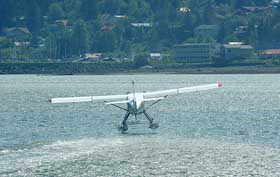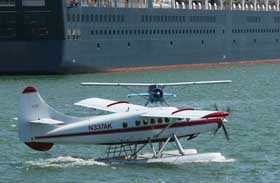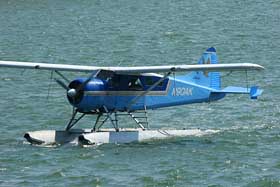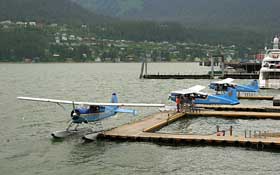

Juneau (Alaska), 2006 Photos © Ruud Leeuw Photos © Ruud Leeuw
|
When I arrived in Juneau I was pleasantly surprised by two things: the weather was bright and sunny, while I had been warned to expect a lot of rain in these parts of Alaska. Two maps will show you that the airport (PAJN) is a considerable distance from "downtown" where our accommodations were (some 20 US Dollars by cab). Overall view and Downtown where the cruiseboats and floatplanes are, at the Juneau Harbor Seaplane Base (5Z1). |
Karl Hayes wrote the authorative monograph on the DHC-3 from which I quote N339AK's history: Otter 454 was delivered to the Tanzanian Air Force on 12th April 1966 with
serial 9104. It
remained in Canada under the care of the RCAF until May 1967, when it was
crated and shipped to
Tanzania, where it was re-assembled and entered service, based at Dar Es
Salaam. 9104
continued in service there until April 1972, when this Otters was one of a
batch purchased by Bannock
Aerospace Ltd of Toronto. |
N91AK is a DeHavilland DHC-2 Beaver, with c/n 737. |
 Classic take off: one float gets unstuck from the water and the other one is followed soon... airborne !
Classic take off: one float gets unstuck from the water and the other one is followed soon... airborne !
|

The Hangar is a nice place to have a meal or drinks; they have a view on the docks and large cruiseships. N337AK is another turbine-converted DHC-3 Otter (c/n 418), built in 1961. It is operated by the same company. |
 Another fine looking Beaver of the DeHavilland kind...
Another fine looking Beaver of the DeHavilland kind...This is c/n 438, presently registered as N90AK for Wings Airways (d.b.a. Wings of Alaska too?). It was delivered on 26Jan53 to the USAF as 52-6076. its civilian career got started with registering it as N5158G in May71 for the Civil Air Patrol Inc. (Hq at Maxwell AFB in Alabama) It became N90AK for Wings of Alaska / Alaska Juneau Aeronautics Inc., Juneau, AK during June 1988. All this and more at DHC-2.com |
| The Beaver was designed for flight in rugged and remote areas of the world. Because it often flies to remote locations (which often are in cold climates) its oil reservoir filling spout is located in the cockpit itself and the oil can be refilled while the aircraft is in flight. Compared to this, flying around Juneau for cruise passengers can only be described as cozy! Despite the fact that production ceased nearly 40 years ago, hundreds of Beavers are still flying—many of them with considerable modifications. Although there have been rumours of Canadian companies manufacturing new Beavers, it remains an out-of-production aircraft. The remaining tooling was purchased by Viking Air of Victoria which manufactures replacement parts for most of the early de Havilland line. On February 24, 2006, Viking purchased the type certificates from Bombardier Aerospace for all the original De Havilland designs. The ownership of the certificates gives Viking the exclusive right to manufacture new Beavers. From: http://en.wikipedia.org/wiki/L-20_Beaver |
 A nice view of the seaplane base for Alaska Coastal Airlines (a.k.a. Wings Airways, a.k.a. Wings of Alaska)
A nice view of the seaplane base for Alaska Coastal Airlines (a.k.a. Wings Airways, a.k.a. Wings of Alaska)
|
Passengers are being boarded on N92AK (c/n 1031) But disaster struck when it hit trees during take off on 23Jul88. It was reported written off and its registration was cancelled in May 1989.
|
| The following info was volunteerd on the Yahoo DHC-2 Beaver forum: "I just ran across a photo of an L-20 cockpit. I did not keep track of the source, but it may be a DeHavilland Photo. Across the bottom is the following text: "The L-20 differed in a number of ways from the civil Beaver. It had four windows in the cabin roof, a Y-type dual control yoke instead of the "throw-over" control in the civil model, and foot brakes in left and right positions (optional on civil models). Seats were of standard fibre to facilitate the use of parachutes. Due to a different carburetor, the L-20 primary quadrant controls were: (left to right) power, pitch and mixture. In the commercial model the controls were: pitch, power and mixture. Army-type radio equipment was used. (DH)" Peter C |
|
YouTube.com has some nice bushflying videos such as this one by Jared Leto Our visit to Juneau was brief, less than 24 hours, but we had a very nice whale-watching trip (about which you can read on my travel report) and I did get to capture a nice amount of floatplanes.
|
|